Nursing Assignment Solution Paper
VerifiedAdded on 2023/01/12
|7
|2017
|57
AI Summary
This nursing assignment solution paper discusses the necessary communication skills and strategies to correct Kirra's case. It covers the importance of maintaining eye contact, personalizing the conversation, showing empathy, and using verbal and nonverbal communication strategies. The paper also explores communication barriers and ethical considerations in counseling Kirra. The role of health professionals such as a dietitian, endocrinologist, and psych-oncologist is discussed, along with the challenges of interprofessional communication.
Contribute Materials
Your contribution can guide someone’s learning journey. Share your
documents today.
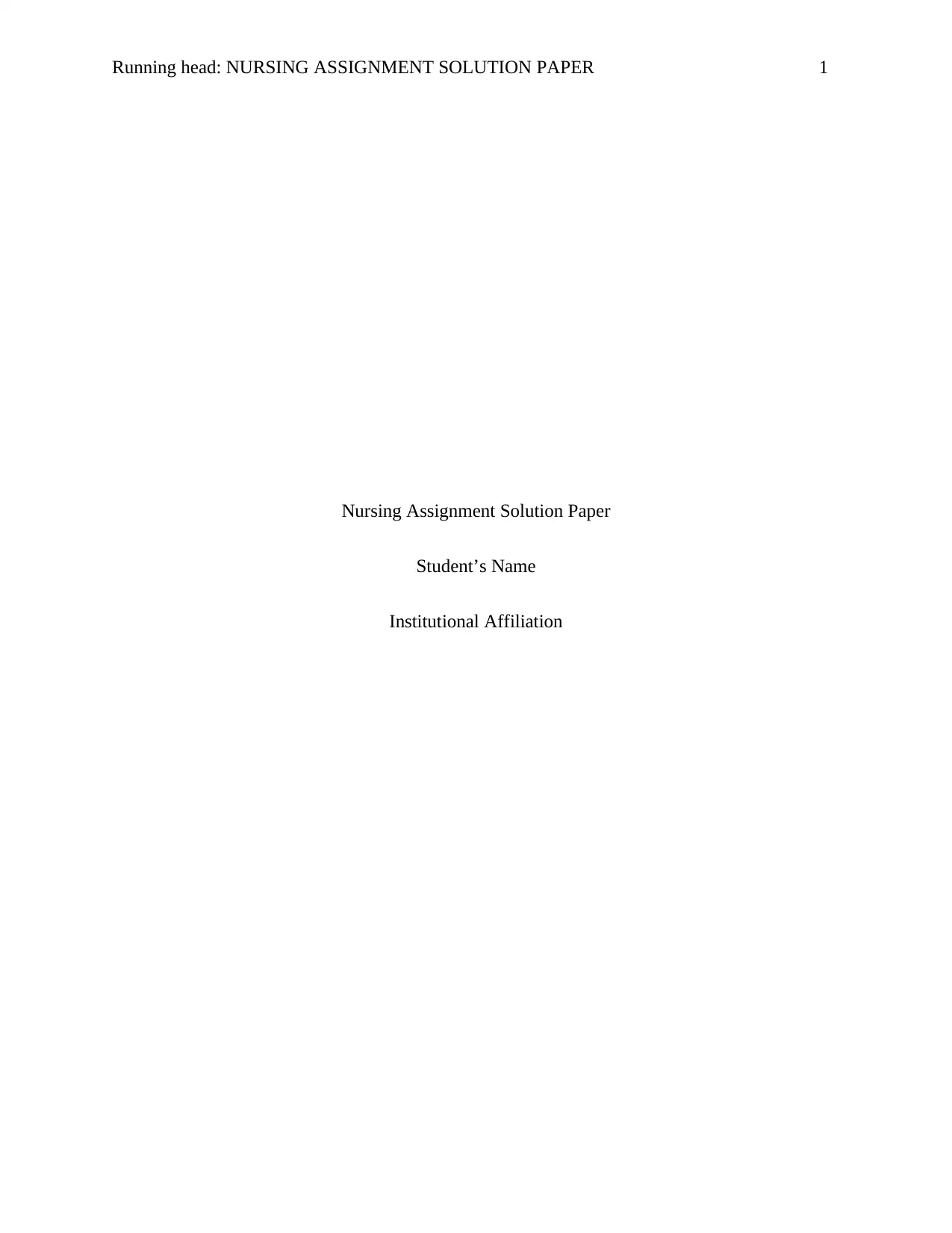
Running head: NURSING ASSIGNMENT SOLUTION PAPER 1
Nursing Assignment Solution Paper
Student’s Name
Institutional Affiliation
Nursing Assignment Solution Paper
Student’s Name
Institutional Affiliation
Secure Best Marks with AI Grader
Need help grading? Try our AI Grader for instant feedback on your assignments.
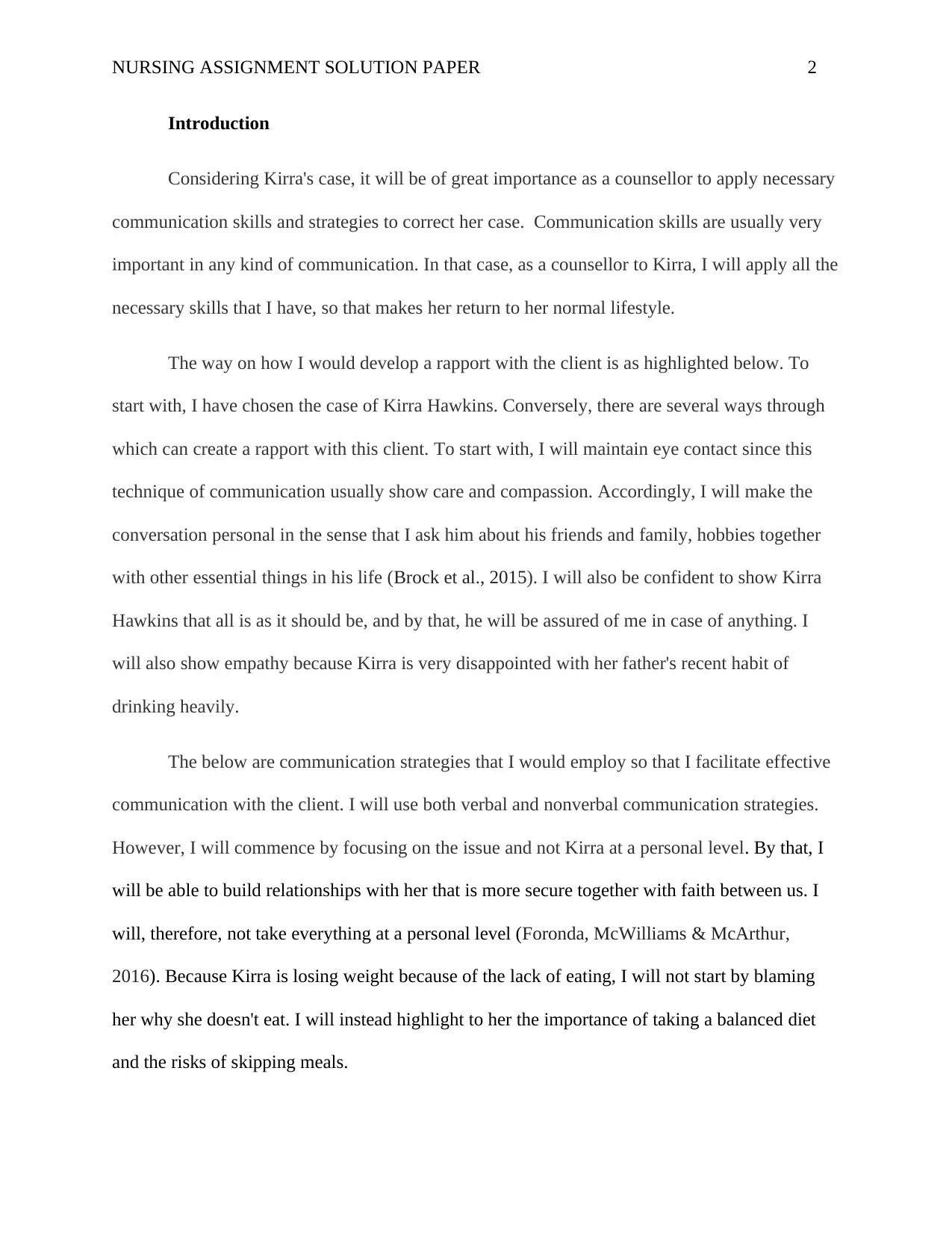
NURSING ASSIGNMENT SOLUTION PAPER 2
Introduction
Considering Kirra's case, it will be of great importance as a counsellor to apply necessary
communication skills and strategies to correct her case. Communication skills are usually very
important in any kind of communication. In that case, as a counsellor to Kirra, I will apply all the
necessary skills that I have, so that makes her return to her normal lifestyle.
The way on how I would develop a rapport with the client is as highlighted below. To
start with, I have chosen the case of Kirra Hawkins. Conversely, there are several ways through
which can create a rapport with this client. To start with, I will maintain eye contact since this
technique of communication usually show care and compassion. Accordingly, I will make the
conversation personal in the sense that I ask him about his friends and family, hobbies together
with other essential things in his life (Brock et al., 2015). I will also be confident to show Kirra
Hawkins that all is as it should be, and by that, he will be assured of me in case of anything. I
will also show empathy because Kirra is very disappointed with her father's recent habit of
drinking heavily.
The below are communication strategies that I would employ so that I facilitate effective
communication with the client. I will use both verbal and nonverbal communication strategies.
However, I will commence by focusing on the issue and not Kirra at a personal level. By that, I
will be able to build relationships with her that is more secure together with faith between us. I
will, therefore, not take everything at a personal level (Foronda, McWilliams & McArthur,
2016). Because Kirra is losing weight because of the lack of eating, I will not start by blaming
her why she doesn't eat. I will instead highlight to her the importance of taking a balanced diet
and the risks of skipping meals.
Introduction
Considering Kirra's case, it will be of great importance as a counsellor to apply necessary
communication skills and strategies to correct her case. Communication skills are usually very
important in any kind of communication. In that case, as a counsellor to Kirra, I will apply all the
necessary skills that I have, so that makes her return to her normal lifestyle.
The way on how I would develop a rapport with the client is as highlighted below. To
start with, I have chosen the case of Kirra Hawkins. Conversely, there are several ways through
which can create a rapport with this client. To start with, I will maintain eye contact since this
technique of communication usually show care and compassion. Accordingly, I will make the
conversation personal in the sense that I ask him about his friends and family, hobbies together
with other essential things in his life (Brock et al., 2015). I will also be confident to show Kirra
Hawkins that all is as it should be, and by that, he will be assured of me in case of anything. I
will also show empathy because Kirra is very disappointed with her father's recent habit of
drinking heavily.
The below are communication strategies that I would employ so that I facilitate effective
communication with the client. I will use both verbal and nonverbal communication strategies.
However, I will commence by focusing on the issue and not Kirra at a personal level. By that, I
will be able to build relationships with her that is more secure together with faith between us. I
will, therefore, not take everything at a personal level (Foronda, McWilliams & McArthur,
2016). Because Kirra is losing weight because of the lack of eating, I will not start by blaming
her why she doesn't eat. I will instead highlight to her the importance of taking a balanced diet
and the risks of skipping meals.
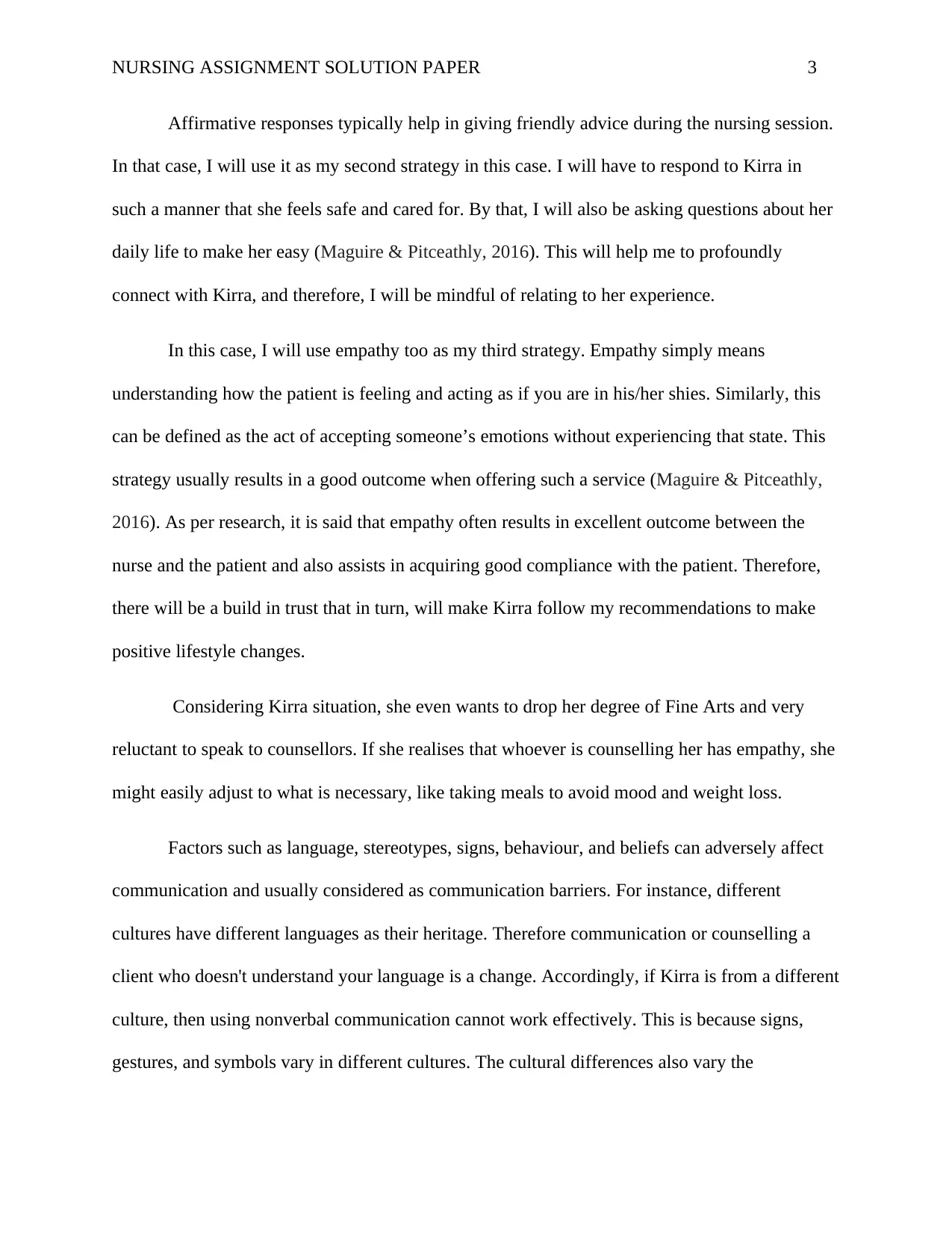
NURSING ASSIGNMENT SOLUTION PAPER 3
Affirmative responses typically help in giving friendly advice during the nursing session.
In that case, I will use it as my second strategy in this case. I will have to respond to Kirra in
such a manner that she feels safe and cared for. By that, I will also be asking questions about her
daily life to make her easy (Maguire & Pitceathly, 2016). This will help me to profoundly
connect with Kirra, and therefore, I will be mindful of relating to her experience.
In this case, I will use empathy too as my third strategy. Empathy simply means
understanding how the patient is feeling and acting as if you are in his/her shies. Similarly, this
can be defined as the act of accepting someone’s emotions without experiencing that state. This
strategy usually results in a good outcome when offering such a service (Maguire & Pitceathly,
2016). As per research, it is said that empathy often results in excellent outcome between the
nurse and the patient and also assists in acquiring good compliance with the patient. Therefore,
there will be a build in trust that in turn, will make Kirra follow my recommendations to make
positive lifestyle changes.
Considering Kirra situation, she even wants to drop her degree of Fine Arts and very
reluctant to speak to counsellors. If she realises that whoever is counselling her has empathy, she
might easily adjust to what is necessary, like taking meals to avoid mood and weight loss.
Factors such as language, stereotypes, signs, behaviour, and beliefs can adversely affect
communication and usually considered as communication barriers. For instance, different
cultures have different languages as their heritage. Therefore communication or counselling a
client who doesn't understand your language is a change. Accordingly, if Kirra is from a different
culture, then using nonverbal communication cannot work effectively. This is because signs,
gestures, and symbols vary in different cultures. The cultural differences also vary the
Affirmative responses typically help in giving friendly advice during the nursing session.
In that case, I will use it as my second strategy in this case. I will have to respond to Kirra in
such a manner that she feels safe and cared for. By that, I will also be asking questions about her
daily life to make her easy (Maguire & Pitceathly, 2016). This will help me to profoundly
connect with Kirra, and therefore, I will be mindful of relating to her experience.
In this case, I will use empathy too as my third strategy. Empathy simply means
understanding how the patient is feeling and acting as if you are in his/her shies. Similarly, this
can be defined as the act of accepting someone’s emotions without experiencing that state. This
strategy usually results in a good outcome when offering such a service (Maguire & Pitceathly,
2016). As per research, it is said that empathy often results in excellent outcome between the
nurse and the patient and also assists in acquiring good compliance with the patient. Therefore,
there will be a build in trust that in turn, will make Kirra follow my recommendations to make
positive lifestyle changes.
Considering Kirra situation, she even wants to drop her degree of Fine Arts and very
reluctant to speak to counsellors. If she realises that whoever is counselling her has empathy, she
might easily adjust to what is necessary, like taking meals to avoid mood and weight loss.
Factors such as language, stereotypes, signs, behaviour, and beliefs can adversely affect
communication and usually considered as communication barriers. For instance, different
cultures have different languages as their heritage. Therefore communication or counselling a
client who doesn't understand your language is a change. Accordingly, if Kirra is from a different
culture, then using nonverbal communication cannot work effectively. This is because signs,
gestures, and symbols vary in different cultures. The cultural differences also vary the
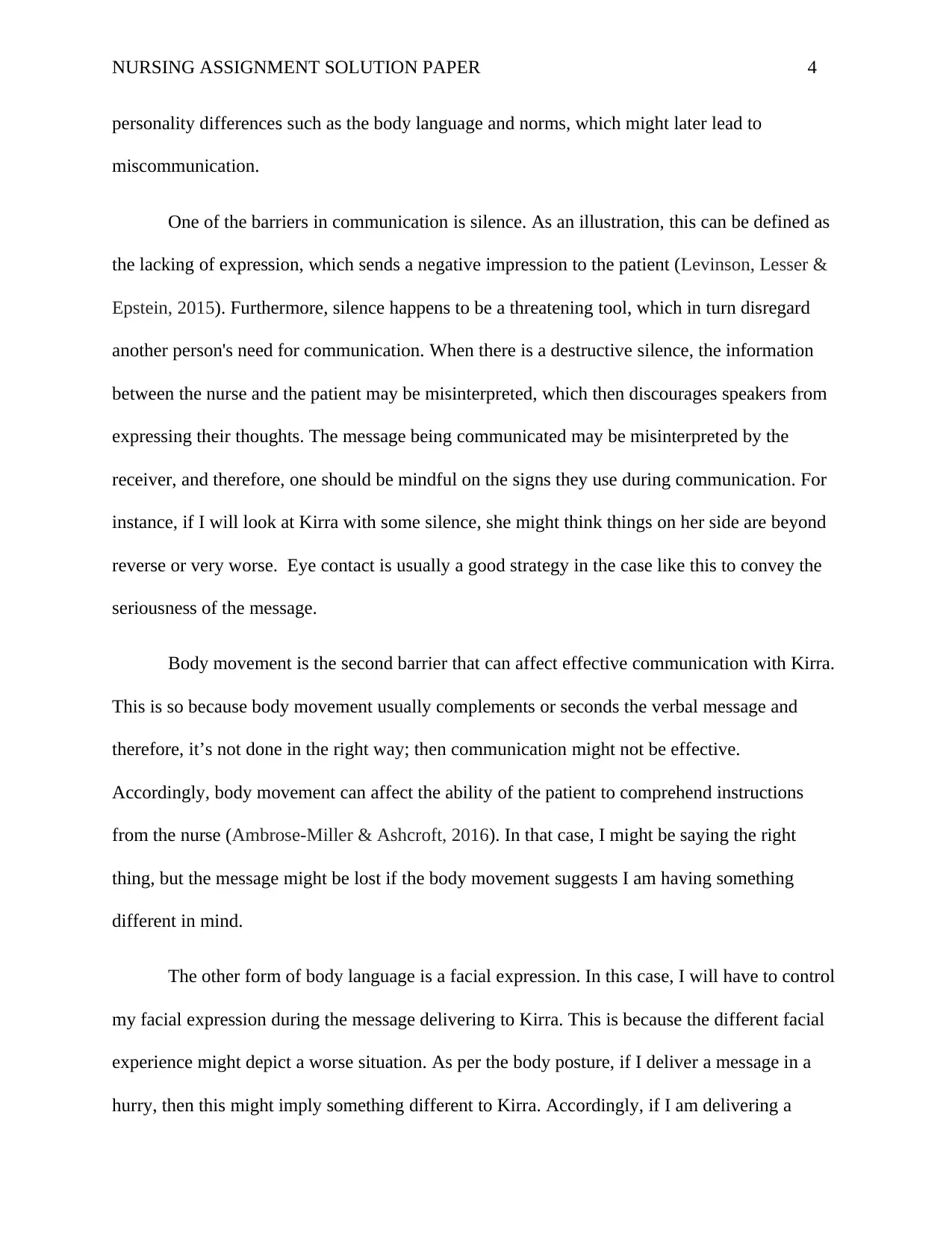
NURSING ASSIGNMENT SOLUTION PAPER 4
personality differences such as the body language and norms, which might later lead to
miscommunication.
One of the barriers in communication is silence. As an illustration, this can be defined as
the lacking of expression, which sends a negative impression to the patient (Levinson, Lesser &
Epstein, 2015). Furthermore, silence happens to be a threatening tool, which in turn disregard
another person's need for communication. When there is a destructive silence, the information
between the nurse and the patient may be misinterpreted, which then discourages speakers from
expressing their thoughts. The message being communicated may be misinterpreted by the
receiver, and therefore, one should be mindful on the signs they use during communication. For
instance, if I will look at Kirra with some silence, she might think things on her side are beyond
reverse or very worse. Eye contact is usually a good strategy in the case like this to convey the
seriousness of the message.
Body movement is the second barrier that can affect effective communication with Kirra.
This is so because body movement usually complements or seconds the verbal message and
therefore, it’s not done in the right way; then communication might not be effective.
Accordingly, body movement can affect the ability of the patient to comprehend instructions
from the nurse (Ambrose-Miller & Ashcroft, 2016). In that case, I might be saying the right
thing, but the message might be lost if the body movement suggests I am having something
different in mind.
The other form of body language is a facial expression. In this case, I will have to control
my facial expression during the message delivering to Kirra. This is because the different facial
experience might depict a worse situation. As per the body posture, if I deliver a message in a
hurry, then this might imply something different to Kirra. Accordingly, if I am delivering a
personality differences such as the body language and norms, which might later lead to
miscommunication.
One of the barriers in communication is silence. As an illustration, this can be defined as
the lacking of expression, which sends a negative impression to the patient (Levinson, Lesser &
Epstein, 2015). Furthermore, silence happens to be a threatening tool, which in turn disregard
another person's need for communication. When there is a destructive silence, the information
between the nurse and the patient may be misinterpreted, which then discourages speakers from
expressing their thoughts. The message being communicated may be misinterpreted by the
receiver, and therefore, one should be mindful on the signs they use during communication. For
instance, if I will look at Kirra with some silence, she might think things on her side are beyond
reverse or very worse. Eye contact is usually a good strategy in the case like this to convey the
seriousness of the message.
Body movement is the second barrier that can affect effective communication with Kirra.
This is so because body movement usually complements or seconds the verbal message and
therefore, it’s not done in the right way; then communication might not be effective.
Accordingly, body movement can affect the ability of the patient to comprehend instructions
from the nurse (Ambrose-Miller & Ashcroft, 2016). In that case, I might be saying the right
thing, but the message might be lost if the body movement suggests I am having something
different in mind.
The other form of body language is a facial expression. In this case, I will have to control
my facial expression during the message delivering to Kirra. This is because the different facial
experience might depict a worse situation. As per the body posture, if I deliver a message in a
hurry, then this might imply something different to Kirra. Accordingly, if I am delivering a
Secure Best Marks with AI Grader
Need help grading? Try our AI Grader for instant feedback on your assignments.
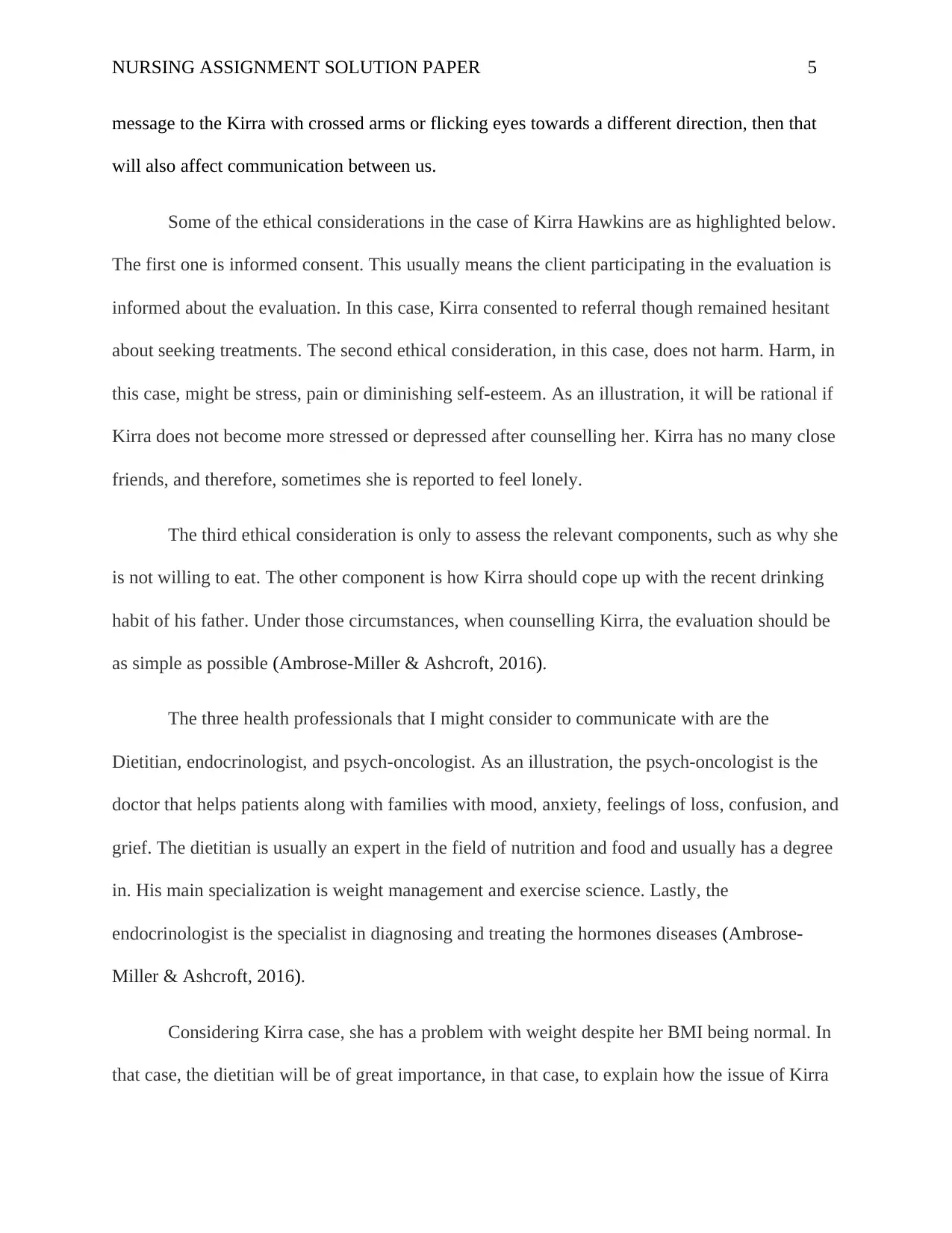
NURSING ASSIGNMENT SOLUTION PAPER 5
message to the Kirra with crossed arms or flicking eyes towards a different direction, then that
will also affect communication between us.
Some of the ethical considerations in the case of Kirra Hawkins are as highlighted below.
The first one is informed consent. This usually means the client participating in the evaluation is
informed about the evaluation. In this case, Kirra consented to referral though remained hesitant
about seeking treatments. The second ethical consideration, in this case, does not harm. Harm, in
this case, might be stress, pain or diminishing self-esteem. As an illustration, it will be rational if
Kirra does not become more stressed or depressed after counselling her. Kirra has no many close
friends, and therefore, sometimes she is reported to feel lonely.
The third ethical consideration is only to assess the relevant components, such as why she
is not willing to eat. The other component is how Kirra should cope up with the recent drinking
habit of his father. Under those circumstances, when counselling Kirra, the evaluation should be
as simple as possible (Ambrose-Miller & Ashcroft, 2016).
The three health professionals that I might consider to communicate with are the
Dietitian, endocrinologist, and psych-oncologist. As an illustration, the psych-oncologist is the
doctor that helps patients along with families with mood, anxiety, feelings of loss, confusion, and
grief. The dietitian is usually an expert in the field of nutrition and food and usually has a degree
in. His main specialization is weight management and exercise science. Lastly, the
endocrinologist is the specialist in diagnosing and treating the hormones diseases (Ambrose-
Miller & Ashcroft, 2016).
Considering Kirra case, she has a problem with weight despite her BMI being normal. In
that case, the dietitian will be of great importance, in that case, to explain how the issue of Kirra
message to the Kirra with crossed arms or flicking eyes towards a different direction, then that
will also affect communication between us.
Some of the ethical considerations in the case of Kirra Hawkins are as highlighted below.
The first one is informed consent. This usually means the client participating in the evaluation is
informed about the evaluation. In this case, Kirra consented to referral though remained hesitant
about seeking treatments. The second ethical consideration, in this case, does not harm. Harm, in
this case, might be stress, pain or diminishing self-esteem. As an illustration, it will be rational if
Kirra does not become more stressed or depressed after counselling her. Kirra has no many close
friends, and therefore, sometimes she is reported to feel lonely.
The third ethical consideration is only to assess the relevant components, such as why she
is not willing to eat. The other component is how Kirra should cope up with the recent drinking
habit of his father. Under those circumstances, when counselling Kirra, the evaluation should be
as simple as possible (Ambrose-Miller & Ashcroft, 2016).
The three health professionals that I might consider to communicate with are the
Dietitian, endocrinologist, and psych-oncologist. As an illustration, the psych-oncologist is the
doctor that helps patients along with families with mood, anxiety, feelings of loss, confusion, and
grief. The dietitian is usually an expert in the field of nutrition and food and usually has a degree
in. His main specialization is weight management and exercise science. Lastly, the
endocrinologist is the specialist in diagnosing and treating the hormones diseases (Ambrose-
Miller & Ashcroft, 2016).
Considering Kirra case, she has a problem with weight despite her BMI being normal. In
that case, the dietitian will be of great importance, in that case, to explain how the issue of Kirra
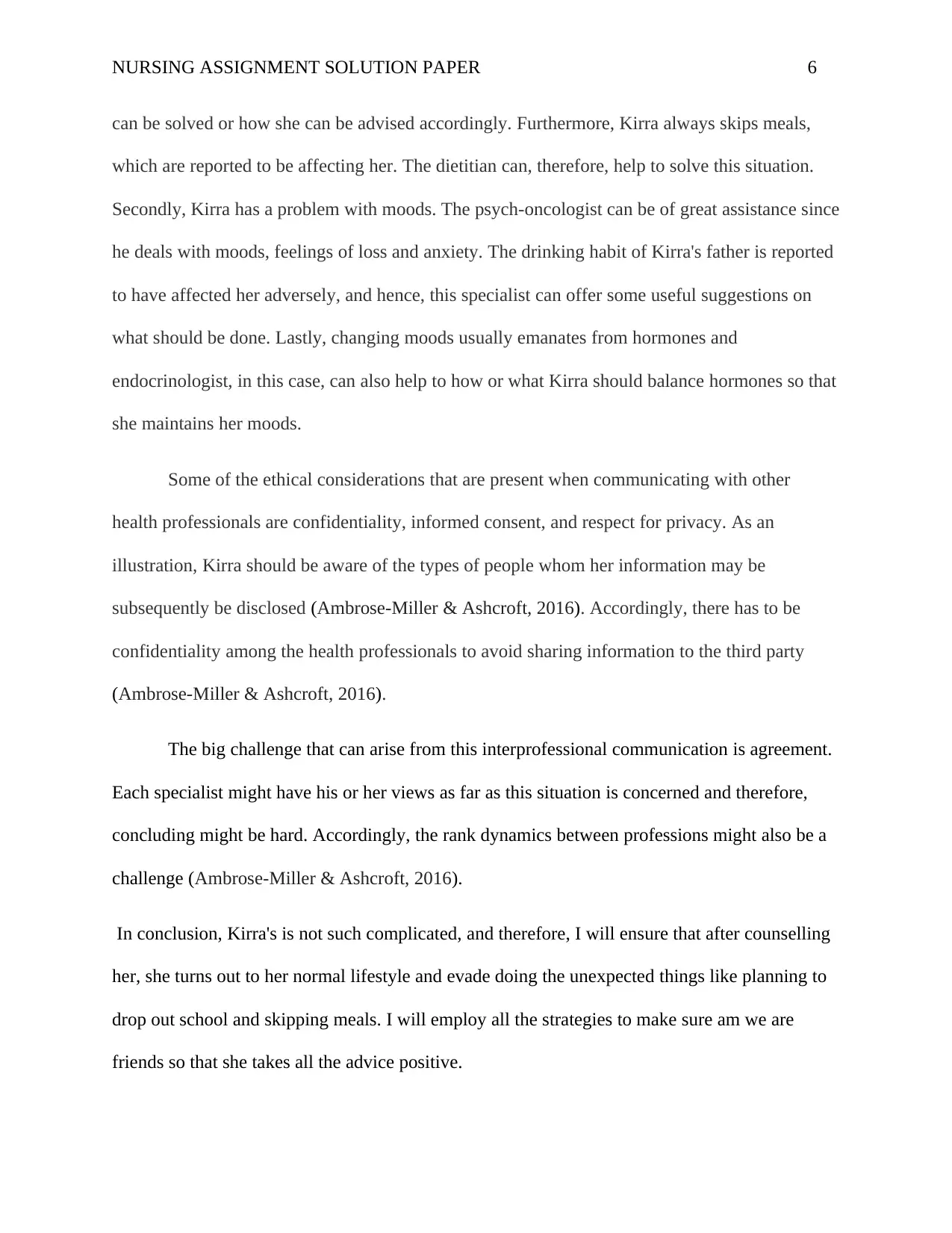
NURSING ASSIGNMENT SOLUTION PAPER 6
can be solved or how she can be advised accordingly. Furthermore, Kirra always skips meals,
which are reported to be affecting her. The dietitian can, therefore, help to solve this situation.
Secondly, Kirra has a problem with moods. The psych-oncologist can be of great assistance since
he deals with moods, feelings of loss and anxiety. The drinking habit of Kirra's father is reported
to have affected her adversely, and hence, this specialist can offer some useful suggestions on
what should be done. Lastly, changing moods usually emanates from hormones and
endocrinologist, in this case, can also help to how or what Kirra should balance hormones so that
she maintains her moods.
Some of the ethical considerations that are present when communicating with other
health professionals are confidentiality, informed consent, and respect for privacy. As an
illustration, Kirra should be aware of the types of people whom her information may be
subsequently be disclosed (Ambrose-Miller & Ashcroft, 2016). Accordingly, there has to be
confidentiality among the health professionals to avoid sharing information to the third party
(Ambrose-Miller & Ashcroft, 2016).
The big challenge that can arise from this interprofessional communication is agreement.
Each specialist might have his or her views as far as this situation is concerned and therefore,
concluding might be hard. Accordingly, the rank dynamics between professions might also be a
challenge (Ambrose-Miller & Ashcroft, 2016).
In conclusion, Kirra's is not such complicated, and therefore, I will ensure that after counselling
her, she turns out to her normal lifestyle and evade doing the unexpected things like planning to
drop out school and skipping meals. I will employ all the strategies to make sure am we are
friends so that she takes all the advice positive.
can be solved or how she can be advised accordingly. Furthermore, Kirra always skips meals,
which are reported to be affecting her. The dietitian can, therefore, help to solve this situation.
Secondly, Kirra has a problem with moods. The psych-oncologist can be of great assistance since
he deals with moods, feelings of loss and anxiety. The drinking habit of Kirra's father is reported
to have affected her adversely, and hence, this specialist can offer some useful suggestions on
what should be done. Lastly, changing moods usually emanates from hormones and
endocrinologist, in this case, can also help to how or what Kirra should balance hormones so that
she maintains her moods.
Some of the ethical considerations that are present when communicating with other
health professionals are confidentiality, informed consent, and respect for privacy. As an
illustration, Kirra should be aware of the types of people whom her information may be
subsequently be disclosed (Ambrose-Miller & Ashcroft, 2016). Accordingly, there has to be
confidentiality among the health professionals to avoid sharing information to the third party
(Ambrose-Miller & Ashcroft, 2016).
The big challenge that can arise from this interprofessional communication is agreement.
Each specialist might have his or her views as far as this situation is concerned and therefore,
concluding might be hard. Accordingly, the rank dynamics between professions might also be a
challenge (Ambrose-Miller & Ashcroft, 2016).
In conclusion, Kirra's is not such complicated, and therefore, I will ensure that after counselling
her, she turns out to her normal lifestyle and evade doing the unexpected things like planning to
drop out school and skipping meals. I will employ all the strategies to make sure am we are
friends so that she takes all the advice positive.
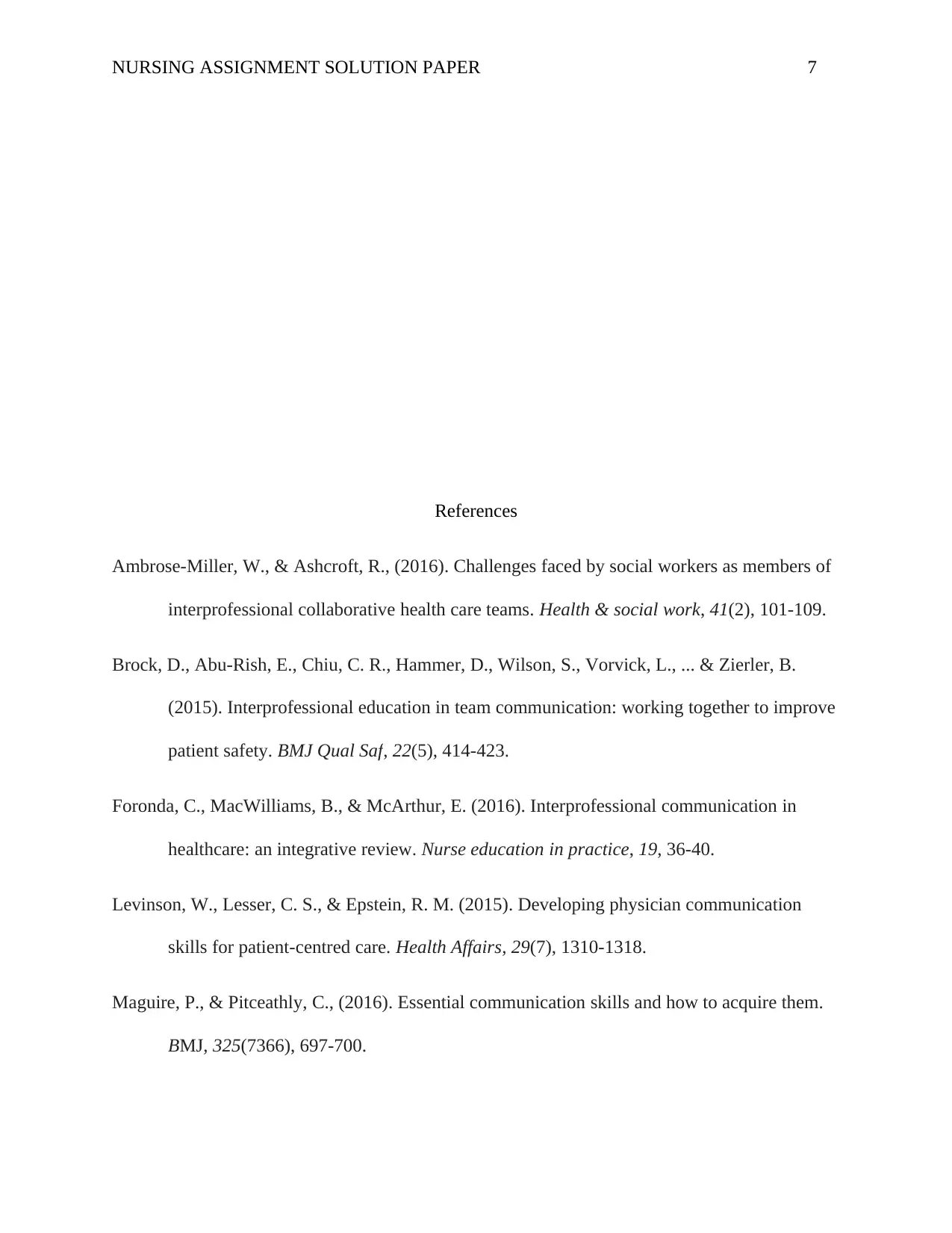
NURSING ASSIGNMENT SOLUTION PAPER 7
References
Ambrose-Miller, W., & Ashcroft, R., (2016). Challenges faced by social workers as members of
interprofessional collaborative health care teams. Health & social work, 41(2), 101-109.
Brock, D., Abu-Rish, E., Chiu, C. R., Hammer, D., Wilson, S., Vorvick, L., ... & Zierler, B.
(2015). Interprofessional education in team communication: working together to improve
patient safety. BMJ Qual Saf, 22(5), 414-423.
Foronda, C., MacWilliams, B., & McArthur, E. (2016). Interprofessional communication in
healthcare: an integrative review. Nurse education in practice, 19, 36-40.
Levinson, W., Lesser, C. S., & Epstein, R. M. (2015). Developing physician communication
skills for patient-centred care. Health Affairs, 29(7), 1310-1318.
Maguire, P., & Pitceathly, C., (2016). Essential communication skills and how to acquire them.
BMJ, 325(7366), 697-700.
References
Ambrose-Miller, W., & Ashcroft, R., (2016). Challenges faced by social workers as members of
interprofessional collaborative health care teams. Health & social work, 41(2), 101-109.
Brock, D., Abu-Rish, E., Chiu, C. R., Hammer, D., Wilson, S., Vorvick, L., ... & Zierler, B.
(2015). Interprofessional education in team communication: working together to improve
patient safety. BMJ Qual Saf, 22(5), 414-423.
Foronda, C., MacWilliams, B., & McArthur, E. (2016). Interprofessional communication in
healthcare: an integrative review. Nurse education in practice, 19, 36-40.
Levinson, W., Lesser, C. S., & Epstein, R. M. (2015). Developing physician communication
skills for patient-centred care. Health Affairs, 29(7), 1310-1318.
Maguire, P., & Pitceathly, C., (2016). Essential communication skills and how to acquire them.
BMJ, 325(7366), 697-700.
1 out of 7
Related Documents
Your All-in-One AI-Powered Toolkit for Academic Success.
+13062052269
info@desklib.com
Available 24*7 on WhatsApp / Email
![[object Object]](/_next/static/media/star-bottom.7253800d.svg)
Unlock your academic potential
© 2024 | Zucol Services PVT LTD | All rights reserved.




